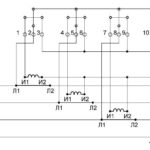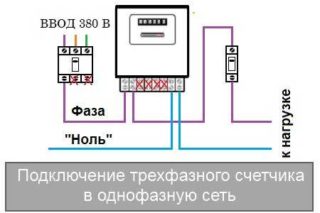Three-phase direct connection controllers are used to meter the consumed electricity. A three-phase meter is allowed to be installed in areas with a combined equipment capacity of more than 12 kW or 60 A, including in residential premises.
- The need for three-phase metering
- Design and work features
- Analog Models
- Electronic models
- Advantages of 3-phase connection
- The specifics of a modern three-phase meter
- Types of electricity meters
- Varieties of connection schemes
- Three-phase meter of direct connection
- Connecting a metering device in a semi-indirect way
- Indirect meter connection method
- The nuances of choosing a counter for 3 phases
- Using a three-phase meter as a single-phase meter
The need for three-phase metering
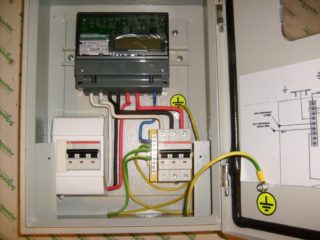
The current standards establish the requirement to use multiphase metering devices with consumer power from 15 to 20 kW. With this indicator, the current in the circuit reaches 70 A, which is unacceptable for apartments.
PUE also indicate that the modern power supply system is designed for 380 V, and only a 3-phase device can correctly take it into account. The entire power consumption can be distributed over 3 cores, so that each will have about 2.5 A of load.
The three-phase system is universal, since it ensures the safe operation of household appliances, reduces the temperature load on the wire and prevents human injury.
A three-phase controller in a private house requires significant material investments.
Design and work features
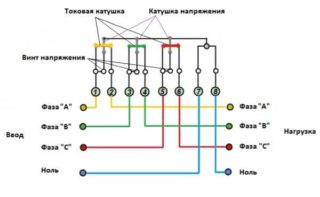
To understand the principles of operation of a 3-phase meter in a network with a rated power of 15 kW or more, it is worth understanding its design. A standard apparatus consists of the following parts:
- collapsible body;
- two windings - voltage and current;
- aluminum disc;
- magnetic disc stopper;
- worm-gear;
- calculating device.
The principle of operation of the device depends on its type.
Analog Models
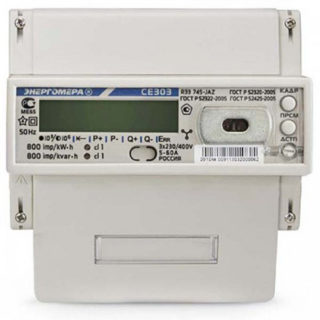
Electrical energy flows through the current coil, creating an electromagnetic field. Further, an eddy current is formed, which ensures the rotation of the aluminum disk. The torsional force is transmitted through the worm gear by a counter mechanism that fixes the consumption of electricity.
The higher the load on the coil, the faster the kilowatts are counted.
Electronic models
The counter has an analog-to-digital converter. Pulses are sent from it to the microcircuit according to the frequency schedule. The microcircuit of a three-phase electronic meter stores information and displays it on the screen.
Electronic devices are often damaged by voltage fluctuations.
Advantages of 3-phase connection
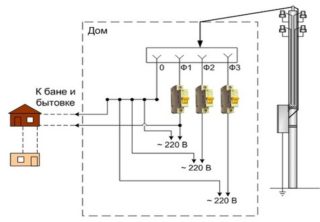
By installing a multi-tariff meter, the owners of a house or apartment receive many benefits:
- economy - some models have day and night charging modes, which allows using less energy at night than during the day;
- versatility - devices can be connected from a standard 220 V network or a new 380 V network directly or through a transformer;
- constant monitoring - the meter balances the mains voltage;
- Accuracy - consumption of electricity is recorded with an error of 0.2 to 2.5%;
- additional functions - the meters are equipped with an event log, an electric power modem, user fixation, a monitor for data output.
The single-phase version gives a reading error of up to 5%.
The specifics of a modern three-phase meter
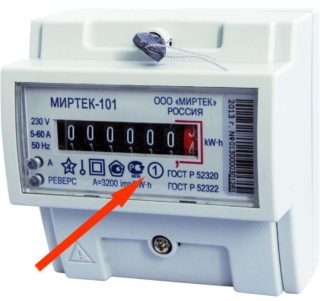
A multiphase device must be reliable, durable, and accurately transmit readings. Therefore, the models of modern manufacturers are endowed with the following functions:
- tracking active and reactive electricity;
- the presence of self-diagnosis;
- taking readings at several rates;
- registration of incidents on the line in the notification log.
Some devices are compatible with smartphones, which makes it possible to track the reading remotely.
Types of electricity meters
Manufacturers produce three types of 3-phase electricity meters:
- Direct connection - similarly to single-phase ones, they are connected to a 380 or 220 V.
- Semi-indirect switching - thrown through a transformer, therefore, they are suitable for a network with a heavy load. The readings are calculated by multiplying the difference between the previous and subsequent data by the transformation ratio.
- Indirect inclusion - connection is made through voltage and current transformers. They are used for electricity metering in high-voltage integration.
The connection diagram of the device will depend on its type.
Varieties of connection schemes
Three-phase meter of direct connection
- The insulating layer is removed from the cable by 5 mm. Oxidations are removed with a solvent.
- The conductors are connected to a three-pole circuit breaker installed for the meter. This is done in order to protect it from a short circuit on the power line.
- There are contacts in the terminal compartment of the device.
- On the odd, 3 phase wires are thrown from the power switch.
- Input and output neutrals are connected to terminals # 7 and # 8.
- After installing the accounting module, an automatic machine is installed, similar to the introductory product.
- The switch is connected to even terminals.
- The equipment is broken down into groups and machines are installed for each phase (for networks with a voltage of 220 V).
The features of the connection diagram can be seen on the cover of the terminal block.
Connecting a metering device in a semi-indirect way
A semi-indirect electric meter is thrown onto metering transformers. It is necessary to count the amount of energy used, focusing on the conversion index. For this, one of the schemes is used:
- Ten-wire. You will need 11 wires that connect from right to left. Phase A is connected to the first 3, phase B is connected to the second 3. Phase C is thrown on cables No. 7-9, and neutral to the tenth. It is necessary to connect a three-phase device with test blocks.
- Star. The use of the circuit allows you to reduce the number of conductors. First, the first unipolar outputs of the secondary winding are assembled at one common point. The next 3 points from the exits are directed to the counter. The current windings are connected.
Semi-indirect models are also allowed to be thrown by means of a current circuit coupler with a voltage circuit.
Indirect meter connection method
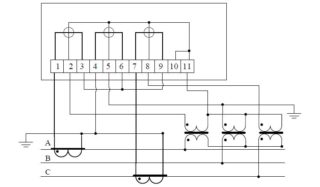
With minimal energy consumption, an indirect connection is relevant. Since an increased current passes through the accounting products, a separate transformer is required. The converter breaks the current winding when connected. The scheme is implemented sequentially:
- Selection of materials for primary and secondary circuits. For the primary, you need a thick conductor passed through the center of the transformer. The secondary is wound from a thin wire.
- Transformers are thrown on each of the phases and attached to the rear wall of the electrical cabinet.
- The ends of the wires of the primary are connected to the machine at the input.
- The second part of the contacts of the primary circuit is connected with separate conductors with a cross section of 1.5 mm2 to terminals No. 2, 5 and 8.
- The secondary coil is connected with similar cables to the conclusions of the meter - 1 to 3, 4, and 6 and 7 to 9.
- A neutral wire is placed on terminal blocks No. 10 and 11.
If the connection sequence is not followed, the meter will transmit incorrect readings.
The nuances of choosing a counter for 3 phases
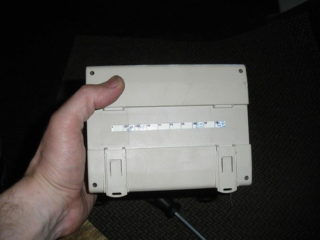
A high-quality three-phase electricity meter will ensure accurate control of energy costs and save money. When buying a device, consider:
- The voltage parameters with which the device is compatible are indicated on the case or in the passport.
- If the installation is carried out outdoors, you need to familiarize yourself with the permissible run-up of temperatures.
- The registration device must have black or red seals on the screw connections. On an electronic device it is one, on an inductive one - two.
- The minimum period for checking the device is once every 8-16 years. A shorter time indicates a poor quality counter.
- Availability of a certificate of conformity to domestic GOST and permission for installation on the territory of the Russian Federation.
- Installation type. A 3-phase meter for fixing energy costs is mounted on bolts or DIN rail.
- Term of seals - must be on the meter for no more than 1 year.
- The accuracy class of a high-quality accounting device is at least 2.
- Power indicators. If all appliances in the apartment use no more than 10 kW in total, a 60 A modification is suitable. An indicator from 10 kW provides for the installation of a 100 A.
- Automated flow control is needed to correctly display information to utility representatives.
- Availability of tariff plans. Two-rate models are scheduled from 7 am to 11 pm and from 11 pm to 7 am. The night tariff provides for the consumption of 50 less electricity.
The new meter can only be connected after it has been sealed by an authorized body.
Using a three-phase meter as a single-phase meter
According to the technical instructions for a network of 15 kW or more, 3-phase meters can be installed. Grid organizations and Energosbyt do not have the authority to indicate the number of connected phases. But this applies only to temporary use for the period of construction work.
Users who decide to turn on a three-phase unit as a single-phase unit need to know the following:
- after the device, you can put 3 separate automatic machines and throw in a 3-phase cable;
- an input is made to the meter, from which 1 phase goes;
- it is impossible to obtain official permission for such a line, since a 3-phase meter is used only on a three-phase four-wire network;
- on analog models, phases cannot be combined;
- when installing an electronic one, each phase is checked in turn;
- the load on the network will be asymmetric, which will lead to equipment breakdowns, accidents, injuries.
Three-phase electricity meter on one phase will incorrectly read the readings.
3-phase power supply networks provide high-quality connection of a large number of powerful equipment - air conditioners, electric stoves, heaters. A three-phase electric meter allows you to control energy costs with high accuracy, it has several tariffs and the ability to be installed on the street.


